Best 5 Compound Microscopes On The Market In 2022 Reviews
Did you ever want to know more about compound microscopes?
Read this post about the compound microscope!
In this post, you will learn more about compound microscopes, what they are and how they work, and you will find detailed reviews on 5 different models of this type of microscope.

What Is A Compound Microscope And How Does It Work?
What Is The Compound Microscope?
The compound microscope is a type of optical (light) microscope, which uses a system of optical lenses to achieve high magnification in the enlarged image of the specimen which is being observed. For that, it uses two lenses, or a group of lenses: the objective and eyepiece lenses. That is the compound light microscope’s definition.
How Does It Work?
A compound microscope utilizes the objective lens to gather light and focus a real image of the object within the microscope. That image is then magnified by the eyepiece lenses that give the viewer a magnified image of the object. This combination of objective + eyepiece lenses enables a higher magnification than what a simple light microscope could provide.
What Types Of Compound Microscope Exist?
There are lots of types of compound microscopes, depending on their purpose. These are just some of them: stereo microscopes (mostly dissecting microscopes), inverted microscopes, comparison microscopes, as well as petrographic, confocal, polarizing, and phase-contrast microscopes.
What Can They Be Used For?
Compound microscopes can be used for any field of study where a high magnification or specific lighting is required. In biology for dissecting microorganisms, in geology for analyzing rock or crystals, for metallography, in chemistry to observe molecular structures, and so on.
How Do They Differ?
Some compound microscopes have specific features. For instance, some have rotating stages, some enable simultaneous observation of 2 specimens, some apply varied illumination effects necessary to observe some less obvious properties of specimens.
Top 5 Compound Microscope For Sale Reviews
Best Monocular Compound Microscope
AmScope M150C-I 1000x Biological Compound Microscope
High Power Student Microscope
This microscope has a 360° rotatable monocular head, with a single widefield eyepiece locked in a 45° viewing angle. There are 5 magnification setting that this microscope has to offer: 40x, 100x, 250x, 400x, and 1000x.
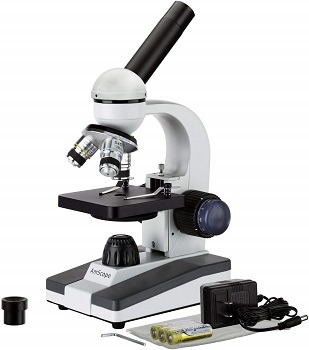
LED Illumination
The AmScope has built-in LED illumination system which can be powered in two way, either via adapter cord from the power outlet or by batteries. In the case of the latter, it uses 3 AA standard batteries that come included with the device, but you can also use rechargeable batteries just as well.
Dual Focusing Knobs
The coarse and fine focus knobs are stacked on each other, for ease of access and practicality. They are located on each side of the device, for easy use by both people who prefer using their right hand and those who prefer their left.
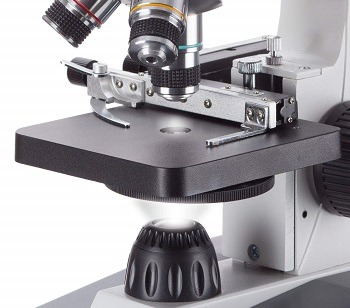
Metal Frame
This compound light microscope has a solid full metal frame with a stain-resistant enamel finish and a fully coated optical system. The dimensions of the device are 15 x 10 x 7 inches, and it weighs 4.5 pounds.
Use And Application
AmScope M150C can be efficiently used as a learning tool in schools, as it is simple and user-friendly, and has all the magnification power that you might need for school research and learning.
- simple design
- good magnification range
- metal frame
- battery/cord powering
- stacked knobs may be clumsy to use
- monocular
Best Binocular Compound Microscope
Celestron CB2000C Compound Binocular Microscope
Compound Microscope Magnification
This device offers as much as 8 magnification settings: 40x, 80x 100x, 200x, 400x, 800x, 1000x and 2000x. This maximum magnification of a compound microscope puts it among the more powerful compound microscopes, even for a lab.
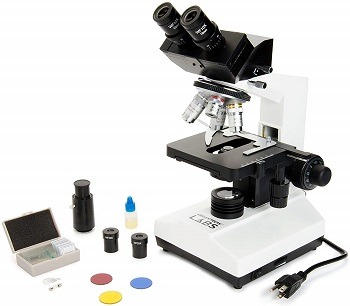
Fully Mechanical Stage
This microscope offers a fully mechanical stage, which can be adjusted in 3 directions. That makes positioning and adjusting slides under the objective easy and precise. The rotating nosepiece has 4 objectives, with 4x, 10x, 40x, and 100x objective lenses.
Binocular Viewing Head
The binocular viewing head has a pair of eyepieces set at a natural viewing angle. The eyepieces can be switched between widefield WF10x eyepieces with a pointer, or the WF20x ones.
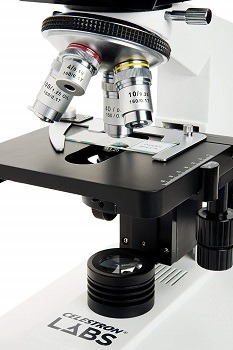
Adjustable Illumination
Celestron microscope has a built-in halogen illumination with Abbe condenser and iris diaphragm. The light intensity can be adjusted by turning a ring in the base of the microscope, and the depth of field can be adjusted by changing the distance between the condenser and diaphragm.
Design And Dimensions
This binocular compound microscope has a construction made fully out of metal, which makes it sturdy and reliable. The dimensions of this device are 11.8 x 12.8 x 17.6 inches, and it weighs 14 pounds.
- fully mechanical stage
- adjustable halogen light
- high maximum magnification
- good magnification range
- binocular viewing head
- made of metal
- powered via cord only
- heavy
- halogen illumination
Best Digital Bright Field Compound Microscope With Camera
Motic BA310 Digital Binocular Compound Microscope
Digital USB Camera
This compound microscope has a 3.0MP CMOS camera, which uses a USB 2.0 output connection for capturing or displaying live video onto a screen of a computer or projector. The camera has a resolution capacity of 3MP (2048 x 1536 p).
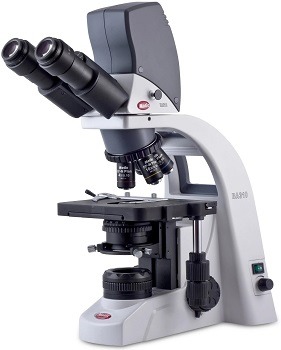
Software Compatibility
The software includes image capture and editing options, and enables both still image and live video capture and editing, as well as measurement functions. This software supports the Motic SFC file format and is compatible with Windows (XP and above) and Mac OS X.
Brightfield Illumination
Kohler brightfield illumination is designed to transmit light through the specimen, in order to enhance the visibility of any translucent and transparent specimens. It allows the specimen to absorb some of that light, which gives you a dark image on a light background. The halogen light emanates bright light in a narrow path, and you can control the light intensity with a rheostat.
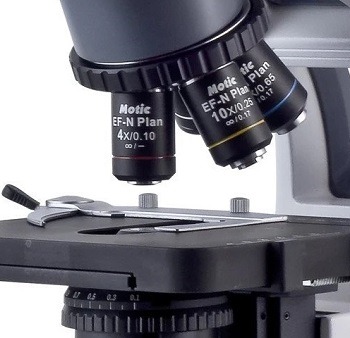
Binocular Head
The binocular viewing head is inclined at a 30° angle, and the eyepieces have an adjustable interpupillary distance (1.9 to 3 inches), as well as adjustable diopter. The eyepieces type is N-WF10x. The nosepiece has 4 objectives, and the magnification range is from 40x to 1000x.
Design And Dimensions
Motic digital compound microscope has a seemingly more complex, professional design, mechanical stage, and a range of adjustable features. The device’s dimensions are 18 x 13 x 29 inches, and it weighs 0.64 ounces.
- digital camera
- brightfield illumination
- rheostat
- lightweight
- wide stage
- widely adjustable
- not fully metal construction
- the camera could be better
Best Laboratory Compound Microscope
Nikon E200 LED Laboratory Microscope
What Does It Have To Offer?
This compound microscope has a uniform bright LED illumination system, combined with Nikon’s high-quality optics. The simple design ensures comfortable use, and the anti-mold coating keeps the device working well even in humid conditions.
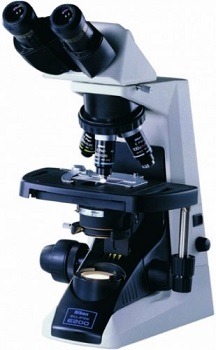
LED Light Illumination
The LEDs provide enough brightness for phase contrast observation as well as simple polarizing observation. Brightness is uniform in the whole field of view, and that is achieved thanks to a fly-eye lens in the bulbs. LEDs consume less power and last longer than halogen lamps, so their replacement cost is greatly reduced.
Nikon Optics
The optics are a combination of Nikon’s well-known CF optics and infinity optics, and they bring you a clear sharp image. And not only that, but they enable higher NA’s and longer working distances, which means easier use of the device with more room for movement. There are 4 CFI E Plan Achromat objectives: 4x, 10x, 40x, and 100x.
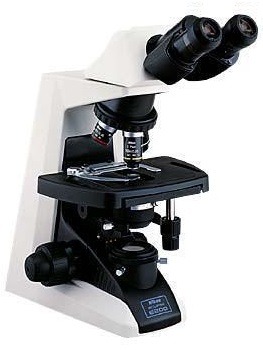
Ergonomic Design
Nikon compound microscope has its focus knobs placed somewhat lower, on the base. This ensures more comfortable use, particularly during prolonged use, as you can rest your arms on the table while using the device. The dimensions of this microscope are 22 x 13 x 15 inches, and it weighs 20 pounds.
Eyepiece Type And Design
The binocular eyepiece set on the viewing head rotates by 180°, which raises the eyepoint height by 1.3 inches. The interpupillary distance is adjustable, and the eyepieces enable a wide field of view and are available in 10x and 15x version. The anti-mold coating will preserve your device’s optics even in a humid and hot environment.
- good optics
- LED illumination
- ergonomic design
- binocular
- heavy
- costly
- no camera
Best Trinocular Halogen Compound Microscope
Omano OM88-T Compound Lab Microscope
Magnification And Optics
This clinical microscope has 4 coated achromatic objectives: 4x, 10x, 40x, and 100x. Combined with the 10x & 16X WF eyepieces, they enable a magnification power of up to 1600x on this compound microscope. All 8 magnification settings are: 40x, 64x, 100x,160x, 400x, 640x, 1,000x and 1,600x.
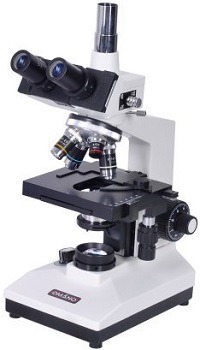
Illumination And Condenser
The Omano microscope features halogen illumination with variable intensity, coupled with an Abbe 1.25NA condenser with iris diaphragm and filter, enables bright and clear images.
Adjustable Viewing Angle
This device has a binocular eyepiece set inclined at 30° for the user’s comfort, as well as dual diopters for adjusting individual eyepiece focus. The head rotates full 360° for easier use and sharing, and the interpupillary distance can be adjusted to anything between 2.2 and 3 inches.
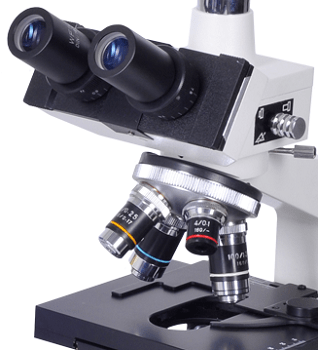
Trinocular Viewing Head
The trinocular viewing head has a binocular set of eyepieces and an additional vertical eyepiece tube, which can be used for secondary viewing or even as a camera mount for recording images of the specimen. Note that you will need to purchase a camera separately.
Coaxial Focus
This compound microscope has coaxial focus controls and a mechanical stage, which means the stage can be moved in 2 direction. This enables easier and more precise adjustments of the slides you are observing, and the fine and coarse focus knobs stacked on each other mean easier access to controls.
- trinocular
- adjustable viewing head
- good magnification range
- focus knobs may be clumsy
- no camera
- halogen illumination
Conclusion: Best Compound Microscopes For Sale
In my view, the best compound light microscopes you can buy are Celestron CB2000C Compound Binocular Microscope and Motic BA310 Digital Compound Microscope. The Celestron has a high maximum magnification power and a fully mechanical stage. Motic has a built-in digital camera, and adjustable brightfield illumination. Motic is also lightweight and has a wide mechanical stage.
If you would like to find out more about microscopes and their types and variations, you can read about light microscopes and stereo microscopes. In case you want to learn about what other microscopes can be found, or you are looking for one yourself, read this post on microscopes for sale.
